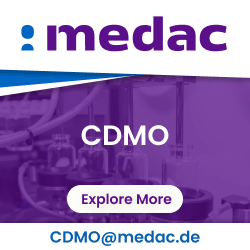Overview of suppository production & formulation & more on leading contract service organizations offering manufacturing services for suppositories.
Q1 What are suppositories and what benefits do they offer?
Suppositories are medicated solid formulations that are inserted into the body through the rectum, vagina, or urethra. They are usually small, round, or cone-shaped dosage forms designed to deliver drugs through rectal and vaginal routes, especially in cases where the oral route cannot be used.
Suppositories are commonly used for pain relief, UTI treatment, and cramps, and are sometimes used as alternatives to deliver drugs to patients that have difficulty taking drugs orally. Manufacturers of pharmaceutical products are currently focused on formulating antiretroviral pharmaceutical suppository medications since retrovirus infections are chronic.
Suppositories are solid at room temperature and dissolve in the body to release the drug in between the temperature range of 30 to 36oC. Suppositories are incredibly effective as they quickly reach other parts of the body through the bloodstream. Once inserted, they dissolve and release the drug almost immediately. Suppositories can also be loaded with much higher levels of active ingredients in comparison to capsules or tablets.
Suppositories are composed of an excipient that dissolves at body temperature. It can either have a natural fat (cocoa butter) base or a polyethylene-glycol (carbowax) base. The selection of a suppository base material depends on the intended use (systemic versus local effect) as well as the route of administration (rectal, vaginal, or urethral).
The current suppository production and development strategy primarily utilizes pre-existing and available suppository dosage forms on the market. The dosage forms are then further integrated with the active ingredients. A manufacturer and exporter of suppositories may offer custom manufacturing and development of suppositories.
Suppositories suppliers or contract manufacturers provide contract services for the development and manufacturing of suppositories and vaginal ovules and at times have additional capabilities for other pharmaceutical products. Such contract service organizations might also offer facilities for continuous suppository manufacturing in large quantities.
Some Benefits of Suppository Pharmaceutical Dosage Forms:
-
The primary advantage of suppositories over other dosage forms is reduced first-pass metabolism.
-
It accommodates patients who have difficulty swallowing pills.
-
It also tends to have a fast action mechanism due to rapid absorption.
-
It provides prolonged drug action.
-
Suppository pharmaceutical dosage forms can be given to an unconscious patient. In addition, it is helpful to promote clearing of the bowel.
-
It does not cause nausea and vomiting or gastric irritation unlike oral therapy.
-
Suppositories are highly beneficial when it comes to hemorrhoids or vaginal infections.
-
Vaginal suppositories provide targeted relief from conditions that affect the vagina.
Q2 What are the ideal properties of suppositories?
Suppositories are an ideal dosage form for rectal and vaginal applications. A rectal and vaginal suppository can partially bypass the liver. Therefore, rectal and vaginal drug delivery can provide significant local and systemic levels of various drugs, despite the relatively small surface area of the rectal and vaginal mucosa. To allow for proper administration and drug delivery, suppositories require careful consideration of the following parameters: color, odor, shape, viscosity, and melting range.
Ideal Suppository Formulations Must Possess the Following Desirable Properties:
-
A suppository should melt at body temperature and disintegrate in body fluids.
-
An ideal suppository should be inert, non-irritating, and non-toxic to sensitive and inflamed tissues.
-
It should be free from objectionable odor and must have an aesthetically appealing appearance.
-
It should be compatible with a wide variety of active pharmaceutical ingredients and excipients.
-
Suppositories should be chemically and physically stable under normal conditions of use and storage.
-
A suppository should have good emulsifying and wetting properties to spread, disperse in, and release the active ingredients at the administration site.
-
It should not bind or interfere with the release or absorption of active ingredients. It should also release the active ingredients readily.
-
A suppository should be stable if heated above its melting point.
-
It should have expansion-contraction characteristics so that it shrinks just enough on cooling and releases easily from suppository molds.
-
The viscosity of a suppository should be low enough in the melt so that it can easily be casted into molds, however it should also be high enough to have suspension of the API solid particles.
-
A suppository should have an acid value below 0.2, an iodine value less than 7, a saponification value that ranges from 200 to 245, and a small range between its melting and solidification points.
Q3 What are the different types of suppositories?
Suppositories have a base made from substances like gelatin or cocoa butter which surrounds an active ingredient or ingredients. Once administered, inside the body, it dissolves or melts onto the mucosal surface, where the drug molecules then diffuse out. Suppositories can be designed in various shapes and sizes because they are used in many different routes of administration (body cavities). Various suppository formulations are explored in detail below.
Rectal Suppository
Rectal suppositories are tapered to resemble a torpedo shape. They usually weigh about 2 g for adults and 1 g for children. In a rectal suppository, active ingredients are mixed with a waxy substance that dissolves or liquefies after being inserted into the rectum. Rectal administration has been used to treat a variety of conditions such as nausea, motion sickness, anxiety, and bacterial infections.
Vaginal Suppository
Vaginal suppositories are solid medications that are inserted into the vagina with a plastic applicator. It is usually in an oviform shape that weighs about 3 to 5 g. The drug is slowly absorbed by the walls in the vagina. This route is often used to give estrogen to women during menopause to relieve vaginal symptoms such as dryness, soreness, and redness.
Pessaries
Pessaries are suppositories intended for vaginal use. They are meant to be inserted into the body through the vagina. They easily dissolve at body temperature and release the drug's content over time. Thus, a pessary is an interchangeable term, referring specifically to a vaginal suppository.
Urethral Suppository
Urethral suppositories called bougies are pencil-shaped and pointed at one extremity. Traditionally, they are cylindrical in shape and vary in length according to gender. Those intended for males weigh 4 g each and are 100-150 mm long, and for females are 2 g each and 60-75 mm in length. Urethral suppositories are typically utilized as a second-line treatment choice for erectile dysfunction, but can also be used as a first-line treatment in selected individuals.
Nasal Suppository
A nasal suppository is called a nasal bougie or buginaria and is meant for introduction into the nasal cavity. It is prepared with a glycero-gelatin base which weighs about 1 gm and is 9-10 cm long.
There are various contract manufacturers or suppositories suppliers that offer pharmaceutical outsourcing services for the above-mentioned formulations. Such suppository manufacturing organizations' product portfolios may also include suppositories from various pharmaceutical therapeutic groups for rectal and vaginal application.
A manufacturer and exporter of suppositories provides contract manufacturing for suppositories and ovules, including vaginal ovules and pessaries, and may provide additional pharmaceutical and analytical services.
Q4 What are the different methods of preparing suppositories?
Suppositories are prepared using various pharmaceutical manufacturing methods. Such formulations can be prepared by rolling (hand-shaping), molding (fusion), cold compression, and automatic mold machine methods. Some different types of preperation methods for suppositories are noted below.
Rolling (Hand-Shaping) Method
This is the oldest and most straightforward method of preparing suppositories. A suppository base with a medicament is prepared by rolling the suppository into the desired shape. The mass is then rolled into a cylindrical rod of the desired length and diameter. However, this method is limited to suppositories made using cocoa butter as the base material because cocoa butter is the only suppository base that can be molded without heat.
Molding (Fusion) Method
Fusion molding involves melting the suppository base and then dispersing or dissolving the drug in the melted base. The mixture is then poured into a lubricated suppository mold, allowed to cool, and the finished suppositories are removed by opening the mold. The molds are generally made of metals like aluminum or stainless steel. The fusion method can be used with all types of suppositories.
Cold Compression Method
Compression molding is a method of preparing suppositories from a mixed mass of a grated suppository base and medicaments, which is forced into a special compression mold. The suppository base and the other ingredients are combined by thorough mixing. The base softens because of the friction in the process. On the other hand, large-scale manufacturing involves cold-compression machines that are hydraulically operated, water-jacketed for cooling, and screw-fed. Pressure is applied via a piston to compress the mass into mold openings.
A manufacturer of pharmaceutical products such as suppository manufacturers can offer suppository contract manufacturing services. A manufacturer and exporter of suppositories usually has several years of experience that has enabled it to gain niche expertise in the contract manufacturing of suppositories.
A manufacturer of pharmaceutical products that offers suppository contract manufacturing services could also provide a wide range of innovative healthcare products in suppositories such as a vaginal suppository, pessary, external liquid, etc.
Q5 Which are the leading pharmaceutical companies offering suppository contract manufacturing services?
Various pharmaceutical manufacturing organizations, including contract manufacturers and suppositories suppliers that have experience in handling rectal and vaginal suppositories and vaginal ovules, offer contract manufacturing services for suppositories along with other pharmaceutical and analytical services.
These leading organizations have years of experience in developing many pharmaceutical products such as suppositories for rectal and vaginal applications. Some of the top suppository manufacturers, CMOs, and CDMOs with suppository contract manufacturing capabilities are mentioned below.
Leading Pharmaceutical Contract Manufacturers Offering Suppository Contract Manufacturing:
Fareva - Suppository Manufacturing
Fareva is a CDMO that offers suppository and cream manufacturing services. They have custom manufacturing facilities for pessaries, solutions, suspensions, emulsions, syrups, powders, lyophilized products, tablets, capsules, ointments, granules, gels, etc. They handle processes under specific constraints associated with drugs and medical devices.
Unither - Contract Manufacturing of Suppositories
Unither Pharmaceuticals has more than 15 years of experience in the contract manufacturing of suppositories and ovules. Unither can easily handle the entire process of suppository production. They have implemented this technology at their production site in France, which is thoroughly inspected and accredited by the relevant European Authorities.
Bliss GVS Pharma - EU-GMP Certified Suppository Manufacturing
Bliss GVS offers custom manufacturing services for suppositories and pessaries. In addition, they have expertise in the development and manufacturing of suppositories, including extensive product offerings in suppositories across various therapeutic categories such as anti-haemorrhoidal, laxative, anti-inflammatory, anti-emetic, and anti-depressant, etc.
Delpharm - Contract Manufacturing for Suppositories and Ovules
Delpharm offers contract manufacturing services of suppositories, licensed products, generics, OTC products, dietary supplements, veterinary products, medical devices, highly active and injectable products. Delpharm has a range of equipment to respond to the both development and manufacturing of suppositories.
Farmar S. A. - Contract Manufacturing for Suppositories and Ovules
Famar is a contract manufacturing organization that offers suppository and cream manufacturing services. Their core contract services involve developing pharmaceutical dosage forms, including semi-solid and liquid forms, and health and beauty products.
Atral - Suppository and Cream Manufacturing Services
Atral's general unit provides contract manufacturing of suppositories, including different pharmaceutical dosage forms such as ovules, hard gelatin capsules, tablets, capsules, etc. along with other pharmaceutical and analytical services.
All Suppliers

















 LGM Pharma accelerates & optimizes the new product pathway from early development through commercialization.
LGM Pharma accelerates & optimizes the new product pathway from early development through commercialization.










